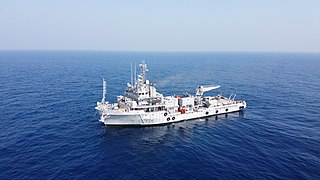
INSVikrant was a Majestic-class aircraft carrier of the Indian Navy. The ship was laid down as HMS Hercules for the British Royal Navy during World War II, but was put on hold when the war ended. India purchased the incomplete carrier in 1957, and construction was completed in 1961. Vikrant was commissioned as the first aircraft carrier of the Indian Navy and played a key role in enforcing the naval blockade of East Pakistan during the Indo-Pakistani War of 1971.

INS Viraat was a Centaur-class light aircraft carrier of the Indian Navy. INS Viraat was the flagship of the Indian Navy until INS Vikramaditya was commissioned in 2013. The ship was completed and commissioned in 1959 as the Royal Navy's HMS Hermes, and decommissioned in 1984. She was sold to India in 1987. INS Viraat was commissioned into the Indian Navy on 12 May 1987, and served for almost 30 years.

The Indian Navy is the maritime branch of the Indian Armed Forces. The President of India is the Supreme Commander of the Indian Navy. The Chief of Naval Staff, a four-star admiral, commands the navy. As a blue-water navy, it operates significantly in the Persian Gulf Region, the Horn of Africa, the Strait of Malacca, and routinely conducts anti-piracy operations and partners with other navies in the region. It also conducts routine two to three month-long deployments in the South and East China seas as well as in the western Mediterranean sea simultaneously.

PNS/M Ghazi (S–130), SJ, was a Tench-class diesel-electric submarine, the first fast-attack submarine in the Pakistan Navy. She was leased from the United States Navy in 1963.

The Shishumar-class submarines are diesel-electric attack submarines, currently in active service with the Indian Navy. These submarines are an Indian variant of the Type 209 submarines developed by the German yard Howaldtswerke-Deutsche Werft under the internal designation "Type 1500". The first two vessels were built by HDW at Kiel, Germany, while the remainder were built by Mazagon Dock Limited, at Mumbai, India, under a technology transfer agreement. The submarines were commissioned between 1986 and 1994. These submarines have a displacement of 1,660 tons when surfaced, a speed of 22 knots, and a complement of 40 including eight officers.

Sindhughosh-class submarines are Kilo-class diesel-electric submarines in active service with the Indian Navy. Their names are in Sanskrit, but in their Roman-alphabet forms sometimes a final short -a is dropped.

The Marine Commando Force (MCF), abbreviated to MARCOS, are the special forces of the Indian Navy. The MARCOS were originally named Indian Marine Special Force, which was later changed to Marine Commando Force to impart "an element of individuality" to it, according to the Indian Navy. The abbreviation 'MARCOS' was coined afterwards.

The Nilgiri-class frigates were updated versions of the Leander class, designed and built for the Indian Navy by Mazagon Dock Limited in Mumbai. Six ships were built between 1972–81. Vessels of the class formed the 14th Frigate Squadron. The lead ship INS Nilgiri was the first major warship to be built in India and was built in collaboration with Yarrow Shipbuilders of the United Kingdom.

INS Sindhughosh (S55) is the lead ship of her class of diesel-electric submarines of the Indian Navy.
UMS Minye Theinkhathu (71) is a Sindhughosh (Kilo)-class submarine owned by the Myanmar Navy. It is the first of two submarines procured by the country's navy, followed by the UMS Minye Kyaw Htin. Before being acquired by Myanmar, it served in the Indian Navy as INS Sindhuvir (S58).

INS Sindhukirti (S61) is the seventhSindhughosh-class diesel-electric submarine of the Indian Navy. She was built at the Admiralty Shipyard and Sevmash in the Soviet Union.

The Kalvari-class submarines, formally classified as the Project-75 submarines (P-75), is a class of diesel-electric attack submarines operated by the Indian Navy (IN). Built by a syndicate of French and Indian shipyards, namely, Naval Group and Mazagon Dock Limited (MDL) respectively, the class is an export derivative of the French-origin Scorpène-class submarine, originally designed by Naval Group.
The Kattupalli Shipyard, officially Adani Katupalli Port Private Limited, is a large shipyard project at Kattupalli village near Ennore in Chennai, being built by L&T Shipbuilding Ltd. It is being set up jointly by TIDCO and Larsen & Toubro (L&T) in two phases. L&T shipbuilding Kattupalli is a minor port. Adani ports and special economic zone (APSEZ) acquired Kattupalli Port from L&T in June 2018 and renamed it as Adani Katupalli Port Private Limited (AKPPL).

INS Vajrabahu is an Indian Navy submarine base of the Western Naval Command located near Mumbai in Maharashtra. It was commissioned on 1 February 1996.

INS Nireekshak (A15) (Inspector) is a diving support vessel (DSV) of Indian Navy. It can also function as interim submarine rescue vessel (SRV).
USHUS is an Integrated Submarine Sonar System developed by the Naval Physical and Oceanographic Laboratory (NPOL) of the Defence Research and Development Organisation (DRDO) of India and manufactured by Bharat Electronics Limited (BEL). It has been developed for use in submarines of the Indian Navy, especially for Sindhughosh-class submarines. Some reports also suggest that Arihant-class nuclear ballistic missile submarines are also equipped with USHUS system. USHUS replaces Russian systems like MGK-400 and MGK-519 sonars on Indian submarines.

INS Vikrant is an aircraft carrier in service with the Indian Navy. The carrier is India's fourth carrier and the first to be built in India. It was constructed by the Cochin Shipyard Limited (CSL) in Kochi, Kerala. The name Vikrant is a tribute to India's first aircraft carrier INS Vikrant (1961). Vikrant means "courageous" in Sanskrit. The motto of the ship, "जयेम सम् युधिस्पृधः" (Sanskrit), means "I defeat those who dare to challenge me" (English). It is currently one of two active aircraft carriers in the Indian Navy, the other being the flagship INS Vikramaditya.















